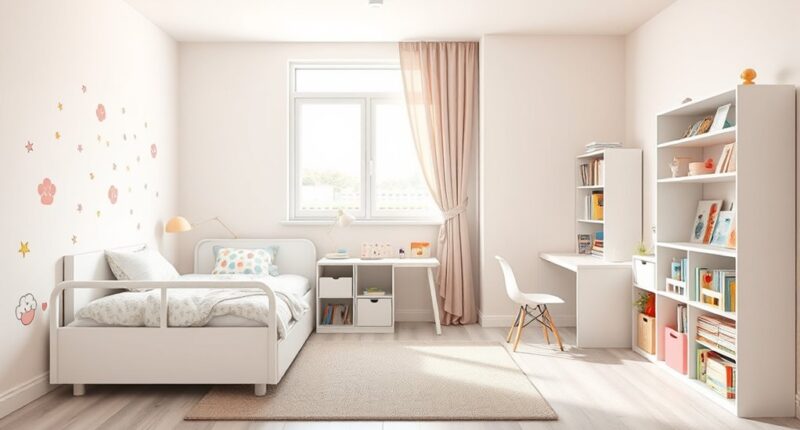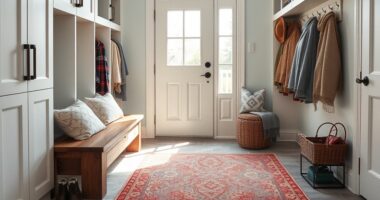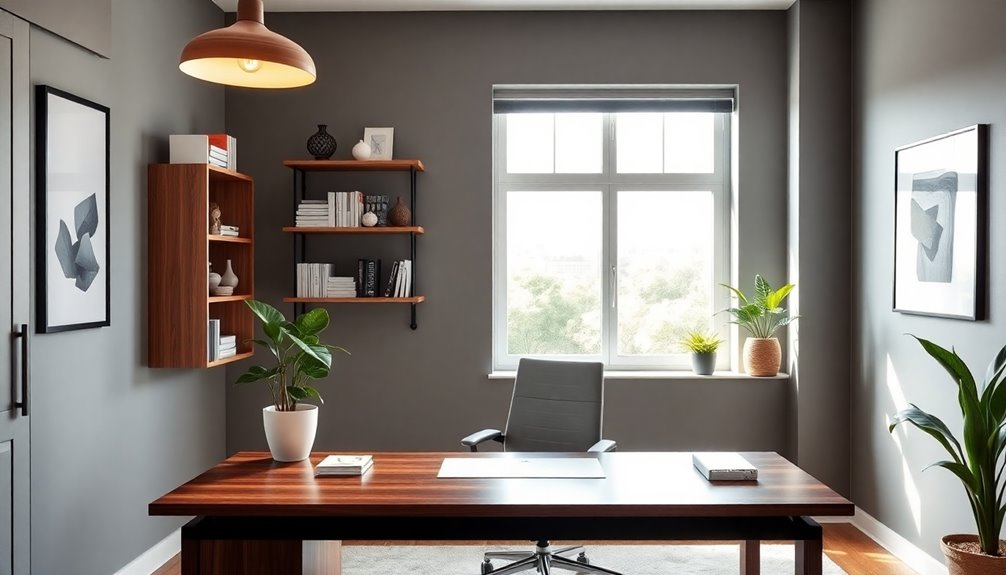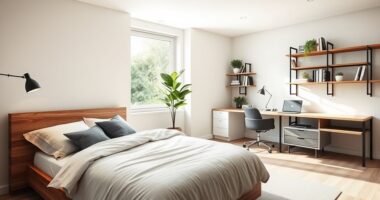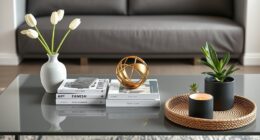To create a kids’ room that grows with your child, focus on neutral colors, flexible themes, and adaptable furniture like adjustable beds and modular storage. Incorporate multi-functional spaces that can serve different purposes over time, while choosing durable, timeless materials for long-lasting style. Keep decor easy to change with removable decals and avoid clutter for safety. Planning for future tech needs and cost-effective updates helps keep the room fresh. Learn how to make it all work seamlessly.
Key Takeaways
- Use neutral colors and adaptable decor to create a versatile space that evolves with the child’s changing interests.
- Invest in adjustable, multi-functional furniture like extendable beds and modular storage for flexibility.
- Design multi-purpose zones combining study, play, and relaxation areas to maximize space and functionality.
- Incorporate removable wall decals, flexible lighting, and safe features to easily update the room’s theme and safety measures.
- Plan for technology integration and cost-effective updates with smart outlets, wireless charging, and budget-friendly decorative accessories.
Embracing Neutral Colors and Flexible Themes
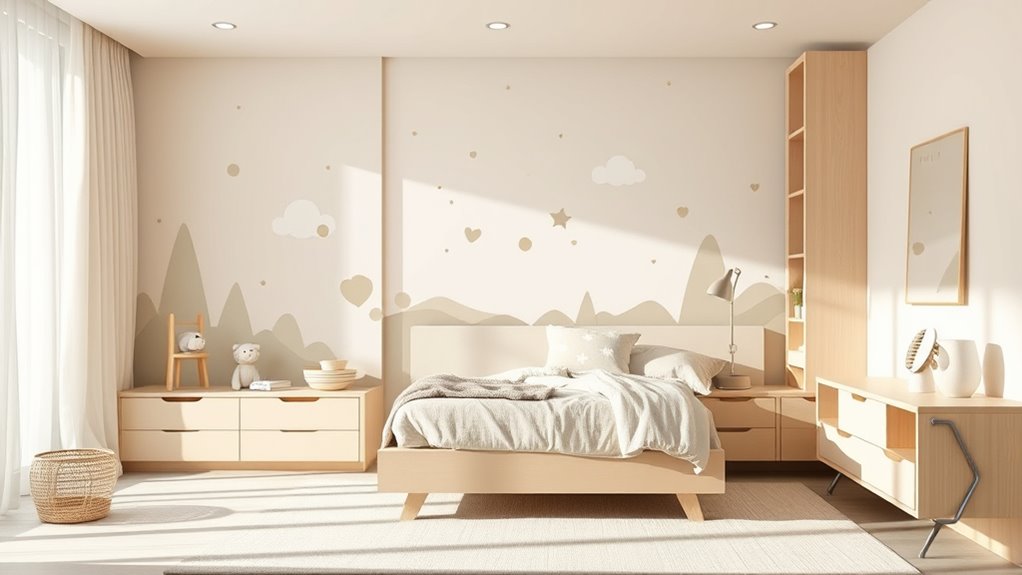
Choosing neutral colors and flexible themes for kids’ rooms allows for easy updates as your child’s tastes evolve. Opt for color palettes with soft, versatile shades like beige, gray, or pastels that serve as a perfect backdrop. These neutral tones make it simple to shift the room’s look without repainting or major changes. Emphasize theme flexibility by choosing decor and accessories that can easily be swapped out—think of removable wall decals, adaptable bedding, or versatile storage solutions. Incorporating DIY farmhouse kitchen accessories can inspire creative, budget-friendly updates that blend practicality with charm. This approach saves money and effort while keeping the space fresh and engaging. By focusing on neutral colors and adaptable themes, you create a room that grows with your child, making updates straightforward and stress-free as their preferences develop over time.
Investing in Adjustable Furniture Pieces
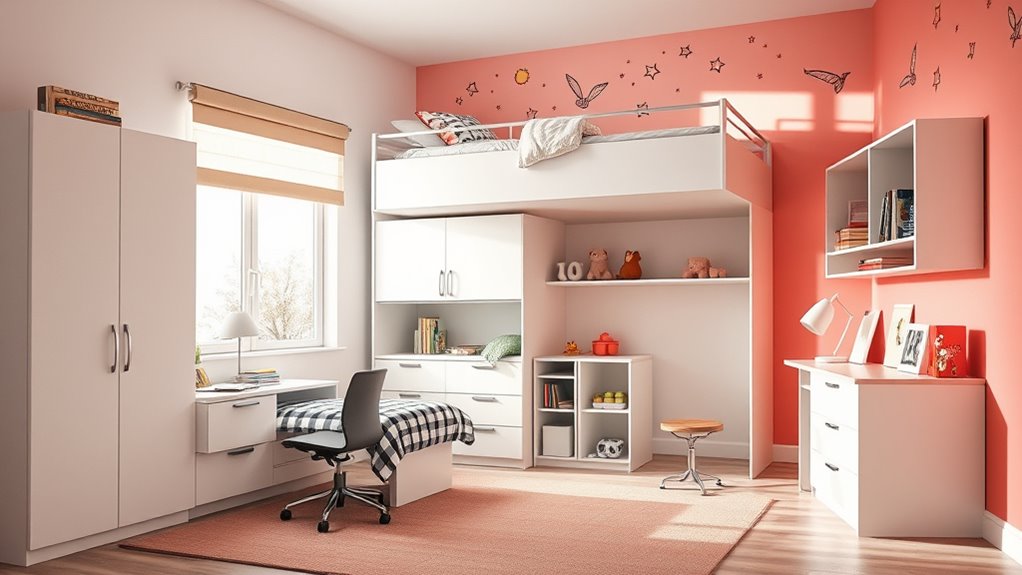
Investing in adjustable furniture allows you to adapt your child’s space as they grow. Modular designs, extendable bed frames, and convertible storage solutions offer flexibility and long-term value. These pieces help create a room that evolves seamlessly with your child’s changing needs. Additionally, choosing furniture compatible with various storage solutions can enhance organization and adaptability over time.
Modular Design Options
Modular furniture offers a flexible solution that adapts as your child grows, making it a smart investment for evolving kids’ rooms. With pieces that can be reconfigured or expanded, you can easily update the space to match their changing needs. Incorporate playful color palettes to keep the room vibrant and engaging, and add themed wall decals to personalize the environment without permanent changes. These modular options allow you to swap out components like desks, shelves, and storage units as your child’s interests shift. This approach guarantees the room remains functional and fun over the years. Plus, it’s cost-effective, since you won’t need to replace entire furniture sets. Instead, you invest in adaptable pieces that grow with your kid’s personality and preferences. Elevate Your Home With the Art of Italian Espresso, creating a cozy and inspiring atmosphere that complements the room’s evolving design.
Extendable Bed Frames
Extendable bed frames are a practical way to guarantee your child’s sleeping arrangements adapt easily as they grow. These frames can often be adjusted to fit different bunk bed configurations, making them ideal for changing needs or shared rooms. As your child shifts from a crib to a toddler bed or moves into a larger bed, extendable frames can be lengthened or widened without needing a complete replacement. Foldaway bed options are also available, allowing for space-saving solutions when extra sleeping space isn’t needed. Investing in these adjustable furniture pieces ensures your child’s bedroom remains functional and flexible over time. With extendable bed frames, you avoid the hassle and cost of frequent upgrades, creating a bedroom that truly grows along with your child. Regularly checking for signs of wear or damage can help maintain safety and extend the lifespan of the bed frame for safety.
Convertible Storage Solutions
Since children’s needs and interests can change quickly, choosing convertible storage solutions allows you to adapt their room efficiently. Opt for furniture that adjusts as they grow, like toy organization units that can be scaled or reconfigured. Wall-mounted desks are perfect because they save space and can be lowered or raised depending on your child’s age and comfort. These versatile pieces help keep the room tidy while accommodating different activities, whether homework or creative projects. Investing in adjustable furniture means you won’t need to replace storage constantly, making it cost-effective too. With these solutions, you can keep their space organized and functional today, while still supporting their evolving needs tomorrow.
Creating Modular Storage Solutions

Creating modular storage solutions allows you to design flexible and adaptable spaces that can grow with your child’s changing needs. Incorporate wall-mounted desks for a streamlined workspace that can be tucked away when not in use, freeing up room for play or relaxation. Use adjustable shelving systems that can be repositioned as your child’s interests evolve or storage needs increase. Fold-away beds are excellent for maximizing space, transforming a bedroom into a multi-use area without clutter. Select furniture with built-in storage compartments to keep belongings organized and accessible. By choosing modular pieces, you can easily reconfigure the room’s layout, making it simple to upgrade or modify as your child grows, ensuring their room remains functional and inviting at every stage. Additionally, considering customizable storage solutions can enhance the room’s adaptability and longevity.
Incorporating Multi-Functional Spaces

To make the most of your child’s room, incorporate multi-functional spaces that serve more than one purpose. This approach lets you maximize space while keeping the room lively and adaptable. Use playful themes and flexible color schemes to create an environment that grows with your child. Think of areas that combine a study nook with a cozy reading corner or a bed that doubles as storage. These setups encourage creativity and comfort, making the room feel inviting. Designing adaptable spaces can help ensure the room remains functional and inspiring as your child’s needs evolve.
- Transform the bed into a play zone with colorful, playful themes
- Design a desk area that doubles as a craft station
- Use vibrant, adaptable color schemes to energize the space
- Incorporate fold-out sofas for sleepovers and lounging
- Create zones that balance work and play seamlessly, sparking joy and functionality
Choosing Durable and Timeless Materials

Choosing durable and timeless materials guarantees your child’s room remains functional and stylish over the years. Opt for sturdy furniture and surfaces that withstand daily wear, making it easier to craft cozy nooks and inviting spaces. Selecting eco-friendly finishes not only benefits the environment but also ensures healthier air quality for your child. Use natural, resilient materials like hardwood or bamboo for flooring, which stand up to activity and can be refinished over time. When choosing paints and finishes, look for low-VOC options to minimize toxins. These choices create a foundation that’s both practical and sustainable. Additionally, understanding local laws and resources can help you navigate any renovations or updates needed as your child grows. By prioritizing durable, timeless materials, you invest in a space that adapts seamlessly as your child grows, reducing the need for frequent replacements or renovations.
Personalizing the Space With Removable Decor

Personalizing your child’s room with removable decor allows for easy updates that reflect their changing interests and personality. Using DIY wall decals or themed wallpaper, you can create a space that feels fresh and uniquely theirs without permanent commitment. These options make it simple to swap out designs as their tastes evolve or to celebrate special milestones. Removable decor also adds a fun, creative element to decorating, empowering your child to participate in their room’s transformation. Imagine their delight when they see their favorite characters or themes come to life, then change as they grow. Incorporating strategic leadership skills into your decorating process—such as planning and adaptability—can make the project more enjoyable and successful.
- Spark joy with wall decals that can be repositioned anytime
- Create a cozy, personalized hideaway with themed wallpaper
- Celebrate new interests without repainting or remodeling
- Keep their room feeling fresh and inspiring
- Make decorating a fun family project
Designing for Safety and Accessibility at Every Stage

Creating a safe and accessible kids’ room requires thoughtful planning that adapts as your child grows. Start with playroom organization by choosing furniture with rounded edges and sturdy storage solutions to prevent accidents. Keep toys and supplies within easy reach to encourage independence, but guarantee clutter is minimized to avoid tripping hazards. For sleep safety, select a mattress that fits the bed frame perfectly and avoid heavy blankets or pillows for young children. Install window guards and outlet covers, and secure furniture to the wall to prevent tipping. As your child develops, update safety features to match their changing needs, ensuring the room remains a secure environment. Incorporating age-appropriate furniture and safety features helps create a space that evolves with your child’s growth. Prioritizing safety and accessibility now sets the foundation for a space that grows with your child.
Planning for Future Technology and Connectivity Needs
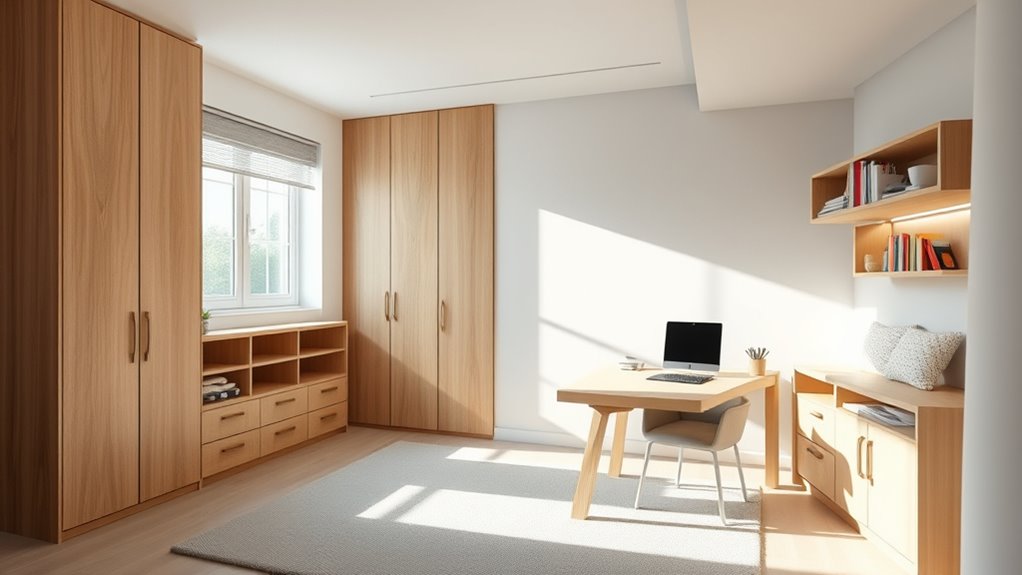
As technology continues to evolve, planning for your child’s future connectivity needs guarantees their room remains functional and adaptable. By integrating smart home features and considering wireless charging stations, you create a space that keeps pace with their growing digital demands. Think ahead with flexible outlets and data ports, so updates are simple and cost-effective. Future-proofing also means designing for seamless smart home integration, allowing easy control of lighting, temperature, and security from a single device. You’ll foster independence and responsibility by encouraging organized charging stations for gadgets. Plus, ensuring strong Wi-Fi coverage throughout the room supports remote learning and entertainment. These steps help create a connected environment that evolves with your child, making their room a comfortable, innovative space for years to come.
Plan your child’s room with smart features and flexible wiring for a future-ready, connected space that grows with their tech needs.
- Feel confident knowing their space adapts effortlessly to new tech.
- Inspire independence with designated charging zones.
- Enjoy peace of mind with reliable, fast Wi-Fi coverage.
- Simplify updates with flexible, accessible wiring.
- Create a room that grows with their digital world.
Tips for Easy and Cost-Effective Room Updates

Updating your child’s room doesn’t have to drain your budget or require complex renovations. Start by crafting themed decor using inexpensive accessories like posters, wall decals, or DIY artwork to refresh the space. These small changes can make a big impact and are easily adaptable as your child’s interests evolve. When selecting finishes, opt for eco-friendly options like low-VOC paints or sustainable materials, which are healthier for your child and better for the environment. Rearranging furniture or adding versatile storage solutions can also instantly update the look without major expense. Incorporating traditional craft techniques like Dragons Beard Candy-inspired textures or decorative elements can add a unique touch. By focusing on simple, thoughtful updates, you can keep the room fresh and functional, ensuring it grows with your child without the need for costly overhauls.
Frequently Asked Questions
How Can I Make a Child’s Room Adaptable for Multiple Age Groups?
To make a child’s room adaptable for multiple age groups, focus on furniture flexibility and color versatility. Choose pieces like beds that convert from cribs to beds or desks that adjust height. Use neutral, versatile colors on walls and decor to easily update the space as your child grows. Incorporate storage solutions that grow with them, so the room remains functional and stylish through every stage of development.
What Are the Best Eco-Friendly Materials for a Long-Lasting Kids’ Room?
Are you searching for eco-friendly materials to create a durable kids’ room? You should consider sustainable finishes and non-toxic paints, which are safe and long-lasting. These materials guarantee a healthy environment while standing up to wear and tear. Think about choosing natural, renewable resources like bamboo or reclaimed wood for furniture. Isn’t it worth investing in finishes that protect both your child’s health and the planet?
How Do I Incorporate Growth-Friendly Lighting Solutions?
You can incorporate growth-friendly lighting solutions by choosing smart bulbs and adjustable fixtures. Smart bulbs let you change brightness and color to suit different activities or moods, making the space versatile as your child grows. Adjustable fixtures, like pendant lights with dimming options, guarantee the lighting adapts to different ages and needs. These options provide flexibility, helping you create a functional, welcoming environment that evolves with your child’s development.
What Are Tips for Maintaining a Child’s Room as Interests Change?
Think of your child’s room as a blank canvas, ready to evolve. To keep up with changing interests, swap out decorating themes and update color schemes easily. Use versatile furniture and accessories that can be repurposed or repositioned. Regularly involve your child in choosing new decor elements, making it a fun, collaborative process. This approach keeps the space fresh, inspiring, and perfectly aligned with their latest passions.
How Can I Optimize Room Layout for Small or Shared Spaces?
When optimizing a small or shared room, prioritize space-saving furniture like fold-away beds or wall-mounted desks. Use multifunctional storage solutions such as shelves that double as seating or under-bed drawers to maximize every inch. Arrange furniture to create clear pathways and designated zones for sleeping, studying, and playing. This approach keeps the room organized, functional, and comfortable, making the most of limited space while ensuring it adapts as your child’s needs evolve.
Conclusion
As your child’s room transforms from playful nursery to teen retreat, think of it as a canvas that evolves with them—neutral tones and flexible furniture blending seamlessly into a space that grows in purpose. While the walls may stay the same, the decor shifts, and the furniture adapts. It’s a clever dance of durability and change, creating a sanctuary that’s both timeless and tailored—ready for whatever the future holds.
